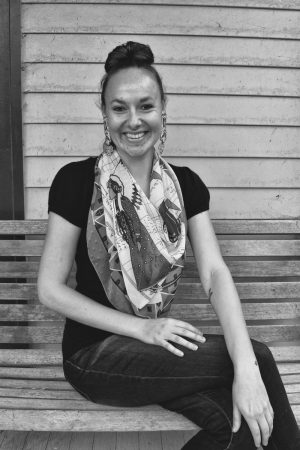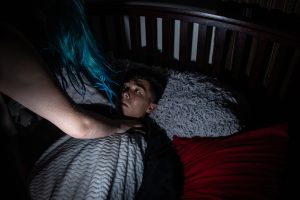Rocky Horror Picture Show virgin sees all
Delve into one of the most interesting cultural touchstones in the U.S.: The Rocky Horror Picture.
October 31, 2018
“How are we going to mark the virgins tonight?” is a question that is only asked on one night of the year: Rocky Horror Picture Show night at the Englert.
Underneath the stage, a flurry of transformations had begun to take place, as actors shifted from their daytime faces into characters only seen past midnight. A man sat cross-legged on the tile floor, gently brushing wigs, while a man with barbed wire painted on his forehead strolled around the narrow hallway playing Led Zeppelin’s “Over the Hills and Far Away” on his guitar.
Despite the circus of makeup and fishnet stockings, amid the tightening of corsets, the cast, along with the organizers of the production, seemed free of the stress and panic that can come with the creation of an interactive show such as Rocky Horror. For good reason: This is Comics in Action’s 10th anniversary of performing Rocky Horror at the Englert.
“The history of our show comes from Comics in Action,” said Dave Atwater, one of the producers of Rocky Horror. “It started out as an improv comedy troupe. We have sold out this show in the last six years.”
The Rocky Horror Show was originally a Broadway musical that débuted in 1974. In 1975, the film of Rocky Horror débuted but did poorly in the box office. Yet, the film had conjured a following of people who didn’t meet the 1975 social norm of “boys like girls” and “girls like boys.”
Movie theaters in such big cities as New York, Chicago, and Los Angeles began to play the film weekly or monthly, attracting the same crowd of people. The audiences yelled obscenities at the characters on the screen, and people recited, or rather, shouted the lines in the dark mask of the theater.
“I don’t know of any other film that has this kind of cult following,” said Dennis Lambing, a producer of Rocky Horror. “They love it because you’re doing things in the theater that you’re not supposed to do.”
Rocky Horror began to transform into an interactive show, one that has actors on the stage while the movie plays on the screen, and the audience is encouraged to throw confetti and toast onto the stage. Participants in the event receive a goodie bag upon arrival, full of items that will be used to act out the events that unfold in the film.
From a bird’s eye view, the audience was a colorful sea of glitter and boas, clad in dramatic makeup and perched on the edge of their seats. It was midnight — showtime. But the lights didn’t dim just yet; the virgins had not yet been marked. First-time attendees of the show are invited up on to the stage, regardless if the stage can fit them or not, and are marked, typically with a large V on their face or, in this case, by mock humping one another on stage.
RELATED: Nine years of Rocky Horror, nine years of inclusivity
Once they were marked, they returned to their seats. The lights dimmed as the audience began to chant, “lips, lips, lips,” and, as if summoned by audience’s excitement, a pair of singing red lips appeared on the screen. Now, it’s showtime.
The beginning scene of a white church, sunshine, and ringing bells did not link arms with the setting of Dr. Frankenfurter’s gloomy castle that the engaged couple, Brad (to which the crowd exclaimed, “a**hole,” upon his arrival) and Janet, (lovingly dubbed “slut” by the crowd) would stumble upon one rainy night. The actors onstage fumbled around, with Janet holding a newspaper over her head.
On cue, the sound of hundreds of newspapers, being freed from their goodie bags, filled the theater, as audience members placed their papers over their heads.
Our main antagonist, protagonist, plot-infusing meddler, and Transylvanian, Dr. Frankenfurter, introduced himself as a “Sweet Transvestite,” and the crowd roared. The actor, wearing a corset, a string of pearls, and high-heel boots, strutted onto the stage with an overwhelming and infectious confidence.
Fans screamed the lines of characters and also insulted specific details about the film’s production. One man yelled, “Same room, different lighting.”
The audience and the actors were fully immersed in their roles, and, plot holes and Meatloaf appearances be damned, the performance swept along at a quick pace.
“It’s a controlled craziness,” said Noelle McVey, who played the role of Columbia. “It’s so incredibly liberating, and it’s so much fun to be that persona.”
As the credits rolled at the end of the night, swarms of smiling, breathless people stepped out into the misty lights outside the Englert. The audience had been given an opportunity to morph into their midnight selves, their different selves, or their true selves, only if for a night.
“The movie is just a reflection of the audience that attends it,” Atwater said. “The desires expressed in the movie are still expressed in the audience today.”






